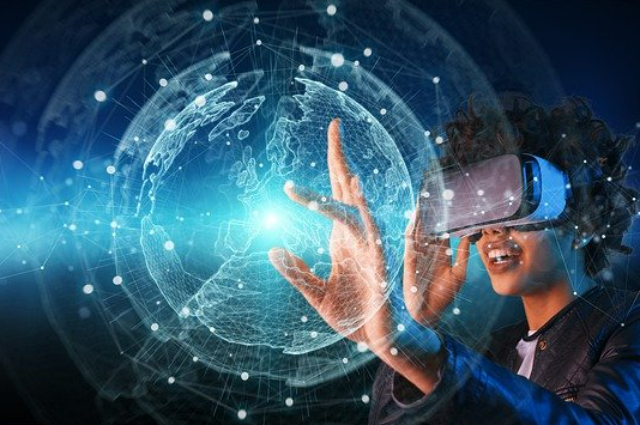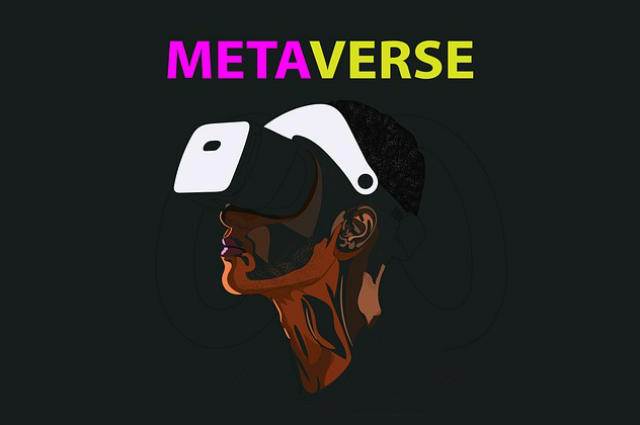Introduction
“The Metaverse is not magic, it is a new world created by aliens from planet Earth to give an infinite experience of the existing world.” - Anuj Jasani
Neal Stephenson in his 1992 novel Snow Crash, proposed the Metaverse as a celebrated idea that related to a lifelong virtual world, a replacement to cyberspace, where individuals spent major portions of their lifestyles in virtual surroundings. People would be able to meet, socialise, play games, buy and trade items, and more in these venues, which would be approachable through special glasses. Second Life, a place to socialise online without plots or problems, was arguably the internet's first attempt at replicating such a world. Digital worlds like Second Life and MindArk's Entropia Universe grew in popularity swiftly, with the former boasting millions of members by the end of the decade.

Over the last year, the term "metaverse" has become popular, conjuring up images of a science fiction future in which a lasting and interconnected virtual reality realm exists. The truth is that numerous early metaverses are currently being developed with a variety of beginning emphasis and theories as to how to get it correctly. Some are for businesses, while others are for consumers. At the heart of each are diverse networks, partners, and technology.
The metaverse is a virtual world that integrates social networking, online gaming, augmented reality (AR), virtual reality (VR), and cryptocurrency to allow people to connect digitally. To improve the user experience, augmented reality combines visual components, sound, and other sensory input onto real-world situations. Imaginary reality, on the other hand, is wholly virtual and enriches fictional realities. As the metaverse expands, it will develop online places that allow for more multidimensional user interactions than current technology allows. Users in the metaverse will be able to surround oneself in an environment where other virtual and mixed-signal worlds collide, rather than only watching digital material.
Why is everybody excited about Metaverse at this moment?
In recent years, a number of causes have propelled it to the frontline of the innovation corporation's perspective. One is that a variety of innovations strongly linked to metaverse perceptions have developed. Virtual reality, which was still in its infancy when Stephenson penned Snow Crash in the 1990s, is now, well, a reality. There are numerous commonly produced headgear, especially separate wireless systems like the Quest. The acquisition of Oculus by Facebook in 2014 had been an initial indicator as to where Zuckerberg saw his company going.

Another is the blockchain, a difficult-to-understand and energy-intensive technology that has enabled cryptocurrencies and NFTs. Over the last year or so, NFTs became a fascination for crypto fans, snake-oil salesmen, easily led executive officers, and (surprisingly) some parts of the art world. They could enable the possession of digital products and real estate within the metaverse.

It should be emphasized that in many games and virtual worlds, including Second Life, it is allowed to "possess" and even sell virtual items without using the blockchain - but such possession is weak and typically subjected to a licensing deal. Different (but equally inadequate) methods of demonstrating ownership are offered by NFTs. Nevertheless, supporters of the metaverse are fascinated by NFTs' novelty and potential portability.
The coronavirus epidemic, which has profoundly transformed lifestyles around the world, is also a crucial contributor in the metaverse movement. With individuals investing so much time in Zoom conferences for business, also with individuals seeking to join increasingly colourful and interesting places without quitting their jobs, it's logical for software developers to explore for methods to benefit on the position by linking these two requirements. The makeover of Facebook and its metaverse-focused mission of the company in late 2021 closed the deal. Ever since, the phrase has become increasingly common – particularly in the corporate sphere. Governments and politicians may take a time to follow up as they concentrate on how to control Big Technology's dominance for the here and now, and also how to offset digital mainstream media negative impacts on ordinary society — which is still a thing.
Lucrative working in metaverse set up
More people are entering the meta-economy as a result of supply and demand relations. This, in return, will entail the acquisition of fresh abilities and the creation of new revenue streams. After all, individuals will be required to create and produce the items that are purchased in the virtual environment, creating enormous prospects for the developer market.
RTFKT, a virtual shoe designer, was officially purchased by Nike. It has built an ecosystem of avatars, spaces, and digital products, in additional to gadgets, and has created a unique linkage between digital and actual products (NFT owners receive physical sneakers that match their NFTs). RTFKT sneakers went for up to $10,000 a pair at a popular auction.
Some individuals, on the other hand, will make a livelihood by delivering service providers metaverse's gig workers. One could, for example, hire a singer or a DJ to present at a virtual party if individuals desire musical entertainment. Virtual performances have the possibility to be more successful than traditional events, which are constrained by factors like space and transportation. Few months ago there was a performance in Fortnite (multiplayer video game series) that was watched by 45 million people and made over $20 million in retail sales. People who would not have otherwise been able to participate in such events owing to geography or expense are now able to do so.

Branding and advertisements could be one of the most important parts of the meta-economy, thus it will be exciting to see how it develops. Because of the large number of people who can access virtual worlds, there are numerous potential for marketing and interactive engagements. Many networks, like the current rise of social media companies, advertising revenue to generate income. By 2027, in-game marketing expenditure is expected to reach $18.41 billion.
Opportunities in a variety of businesses and locations have increased
The benefits will not be limited to business-to-consumer transactions. Business-to-business firms will have a huge advantage in the metaverse. Consider a company that is in the market for new machines and material. At the moment, the procedure entails obtaining a printed brochure or an emailed PDF containing static 2D images. Consumers could evaluate goods in a virtual space for a lesser rate in the metaverse. Consider becoming able to create a large-scale virtual model of a manufacturing or commercial location to evaluate how robotics technologies interact with the original world.
One of the metaverse's most exciting prospects is that it will dramatically increase accessibility to the marketplaces for customers in rising or developing countries. The internet has indeed opened up access to existing unreachable products and services. Employees from poor countries, for example, may now be able to find work in western corporations without migrating. Virtual reality environments will also enhance educational options, as they are a low-cost and efficient way to learn. There will have to be strong management as a result of these advancements.
There are chances to significantly expand as a business standpoint. Rather than opening storefronts in every city, a large retailer may create a worldwide centre in the metaverse that can handle large customer base. Outside retailers, the metaverse will accelerate the migration from cash to crypto in gaming, sports betting, and gambling. Whether cash to cryptocurrency, sports betting and gambling are available. Companies like Sightline Payments, which have established infrastructure to facilitate cashless digital gambling for live sports and casinos, are well positioned to profit as these industries swiftly convert to giving metaverse events to players.
Challenges faced in Metaverse
The fundamental AR and VR technologies provide a variety of issues for the Metaverse. Both systems are convincing and have the ability to affect users' thoughts, feelings, and behaviours. The expensive cost of materials is a stumbling block to widespread acceptance, although it is likely to be overcome in time. AR risks are classified into four categories:
- physical well-being, healthcare, and protection;
- psychology;
- morals and ethics; and
- data privacy
On a scientific level, consumers' focus being diverted by location-based AR applications has resulted in dangerous mishaps. Overloading on data is a psychological problem that must be avoided. Unauthorized augmenting and fact modification to promote prejudiced viewpoints are moral dilemmas. The issue having the broadest repercussions in terms of privacy is data gathering and exchange with third parties. The additional information layer could provide a potential privacy risk. Privacy issues may arise as a result of volume recording and spatially doxxing. Furthermore, Metaverse players may be enticed to collect users' biometrics psychography depending on the user information feelings. These profiles could be used to make unintentional behavioural conclusions, which could lead to algorithmic bias.

Movement sickness, nausea, and confusion are some of the most regularly documented health issues associated with virtual reality. Due to the weight of VR headsets, head and neck strain is a restriction for prolonged use periods. Persistent VR use can lead to addiction, social isolation, and withdrawal from real-world activities, which is frequently accompanied by body neglect. Toxic, antisocial conduct, including as griefing, cyberbullying, and harassment, is another well-known disadvantage of open social environments.
Conclusion
The notion of the Metaverse is not new. However, in the context of MR (mixed reality) , it can combine social media connections with the unique benefits of VR (virtual reality) and AR (Augmented reality) immersive technology. If the interaction between them is properly unlocked, it has the potential to alter numerous industrial areas, including remote online learning. New Meta-education systems, such as Metaverse-powered virtual online classes, could arise, allowing for rich, hybrid verbal and nonverbal educational opportunities in online 3D virtual institutions. The Metaverse's online learning will be capable of breaking the final barrier between human engagement and mentoring programs. Physical attendance in a classroom will no longer be considered a unique instructional opportunity. In particular, in the Metaverse, social mixed reality can permit integrated active pedagogies that develop deeper and longer-lasting understanding. Further significantly, technology has the potential to democratise education by allowing global participation on an equal level, regardless of geography.
. . .
References:
- www.wired.com
- www.polygon.com/metaverse
- time.com/6116826/what-is-the-metaverse
- www.investopedia.com/metaverse
- seekingalpha.com/article
- www.bloomberg.com/professional
- www.businesswire.com/news
- www.techtarget.com/whatis/feature
- www.goodreads.com/quotes
- www.washingtonpost.com/business
- www.researchgate.net/publication
- grayscale.com/wp-content
- www.jpmorgan.com/content
- www.accenture.com/_acnmedia
- www.w3.org/2008/WebVideo
- www2.deloitte.com/content
- researchportal.helsinki.fi/files
- srushticreative.com/wp-content
- www.gsma.com/asia-pacific/wp-content

